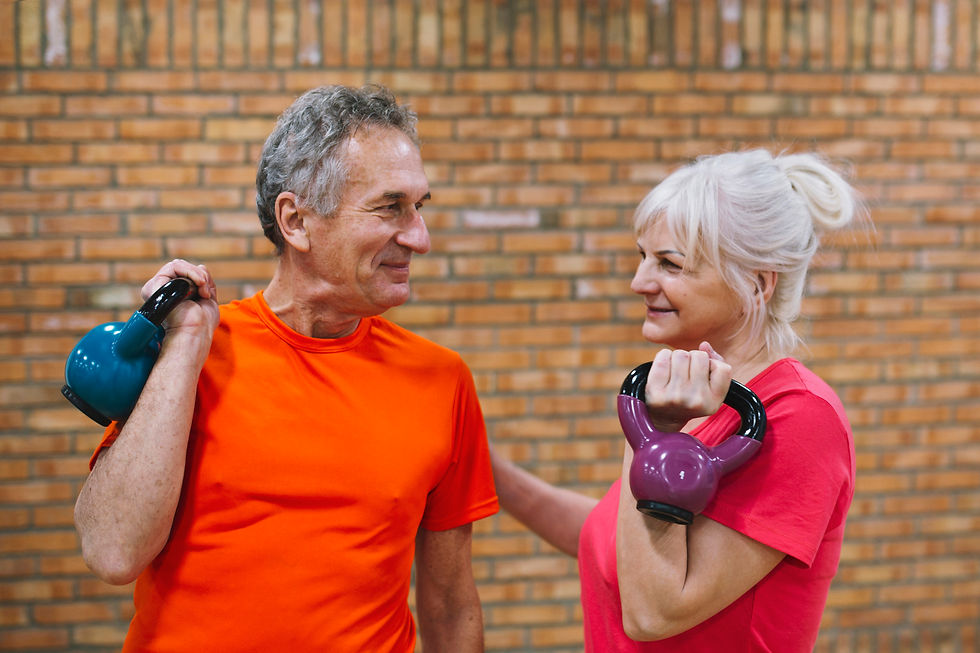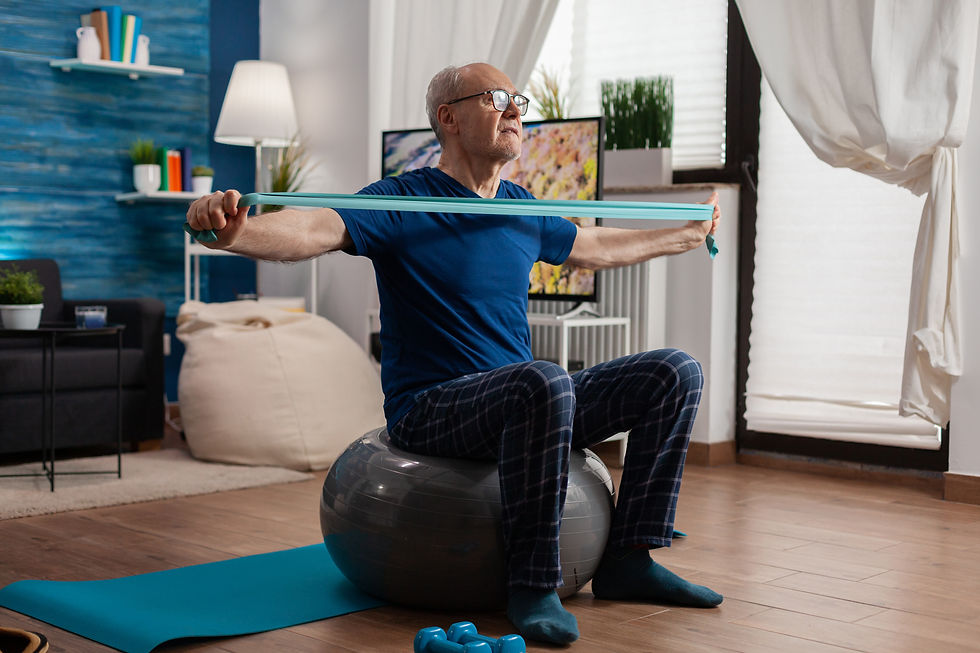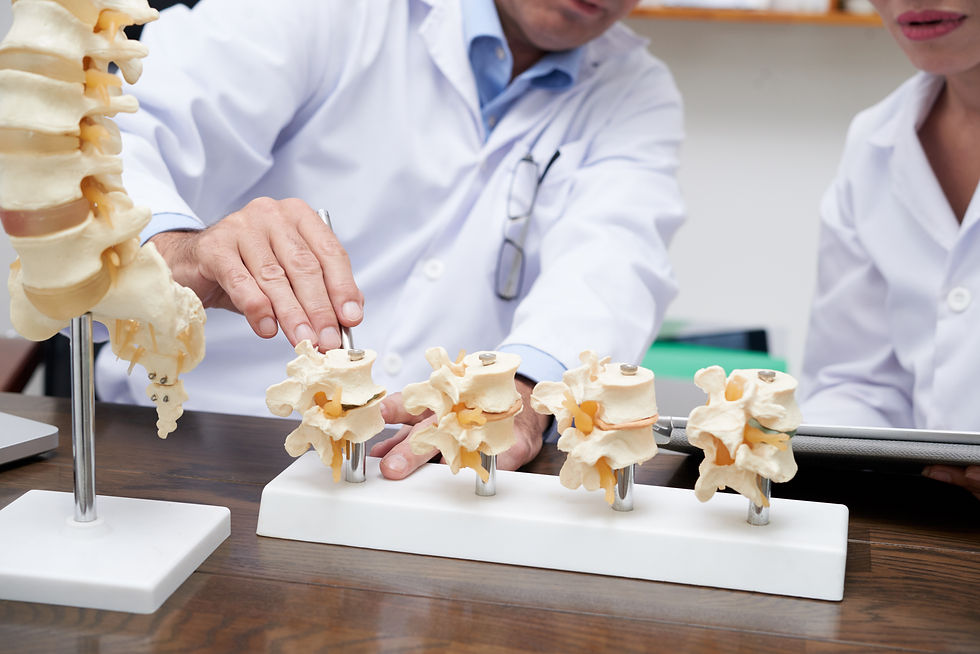Why It’s Never Too Late to Begin Exercising—and How to Incorporate the Four Pillars of Exercise
- Jordan Pollard

- Mar 25
- 6 min read

One of the most common questions I hear from people over 50 is: “Is it too late for me to start exercising? Can I still make a difference in my health?” If you’ve ever wondered this yourself, let me put your mind at ease right now—no, it is absolutely not too late. But the more important message here is: don’t wait.
I often explain this using a simple analogy—one that many of my clients have found helpful. Imagine we’re talking about saving for retirement. If I were a financial advisor speaking to a young person just entering the workforce, I’d tell them that starting early is key. The power of compounding interest means that the earlier you begin saving, the more financial security you’ll have later in life. Even if you’re not an expert investor, consistently setting money aside from a young age will likely lead to a stable retirement.
But what if you’re not 22? What if you’re 45 or even 65, and you haven’t had the chance to save? Would I tell you, “Well, it’s too late—don’t even bother”? Of course not! You’d simply need a different approach: contributing more consistently, taking strategic (but not reckless) risks, and being smart about where you invest your time and effort.
The same logic applies to exercise. If you’ve been active your whole life, great! You have a head start. But if you haven’t, that doesn’t mean you should throw in the towel. You just need a structured, intentional plan—one that maximises the benefits of exercise while minimising the risks.
This is where the four pillars of exercise come in: stability, strength, aerobic efficiency (Zone 2 training), and peak aerobic output (Zone 5 training). If you’re over 50 and new to exercise, focusing on these four areas will give you the best return on investment for your health and longevity. Let’s break them down in more detail.
Pillar 1: Stability—The Foundation of Movement
Stability is the unsung hero of fitness. It’s what allows you to move safely, maintain balance, and avoid injury. When we talk about stability, we’re really talking about your body’s ability to control and dissipate force effectively.
A common misconception is that balance and flexibility are separate from stability, but they’re actually deeply connected. Think about it—if you have good balance, you must have stability. If you have good flexibility, it’s only because your muscles and joints are stable enough to support a full range of motion.
For those over 50, stability training is crucial because it helps prevent falls, one of the leading causes of serious injury in older adults. It also allows you to build strength and endurance without unnecessary strain on your joints.
How to Train Stability
Single-leg exercises (like standing on one leg or doing step-ups) challenge your body’s ability to stay upright and controlled.
Core training (planks, dead bugs, and anti-rotation exercises) enhances your ability to resist unwanted movement, which translates to better posture and overall stability.
Controlled mobility work (slow, intentional movements through a full range of motion) ensures your joints stay strong and resilient.
If you’re brand new to exercise, even simple activities like standing on one foot while brushing your teeth can be a great start. The key is to challenge your balance in a controlled way—without risking falls or injury.
Pillar 2: Strength—Your Best Tool Against Aging
If I could get every person over 50 to embrace one type of exercise, it would be resistance training. Why? Because strength is the single best predictor of healthy aging. It protects against frailty, supports joint health, preserves bone density, and even improves cognitive function.
Many people hesitate to lift weights because they fear injury. But the truth is, not lifting weights is far more dangerous. Without resistance training, we naturally lose muscle mass as we age—a process called sarcopenia. This leads to weaker bones, slower metabolism, and an increased risk of falls and fractures.
How to Train Strength Safely
Bodyweight exercises (squats, push-ups, and bridges) are a great place to start.
Resistance bands (banded rows, chest presses, and deadlifts) provide controlled resistance without the intimidation of heavy weights.
Dumbbells or kettlebells (kettlebell swings, dumbbell overhead press, and goblet squats) allow you to progressively build strength over time.
A simple guideline: focus on compound movements (exercises that work multiple muscle groups at once) and perform them 2-3 times per week. If you’re just starting out, working with a knowledgeable exercise physiologist or trainer can help you build confidence and proper technique.
Pillar 3: Aerobic Efficiency (Zone 2 Training)
Zone 2 training is defined as the highest metabolic output/work that you can sustain while keeping your lactate level below two millimoles per litre, referring to low-to-moderate-intensity cardiovascular exercise that improves your body’s ability to use oxygen efficiently. This is where the magic of longevity happens.
Most people think cardio means pushing yourself to exhaustion. But Zone 2 training is actually quite gentle—you should be able to hold a conversation while exercising but be just at that threshold of not being able to carry on a conversation; if you were on the phone with a friend they would know you are exercising. Over time, this type of training strengthens your heart, enhances fat metabolism, and improves mitochondrial density & function (your body’s energy production system).
How to Train in Zone 2
Continuous exercise is the goal, seek exercises (brisk walking, cycling, and dancing) you can execute for the whole duration of the session.
Rate of Perceived Exertion (RPE) is the most effective way to make sure you are exercising within the right zone, aiming for an RPE of 3-5/10.
Steady heart rate (HR) while exercising (180 minus age) can be a great way when getting started with zone 2, though if you have been inconsistent, just starting, or just getting back into training, subtract an additional 5.
Aim to exercise 3-4 times per week, around 40-60 minutes per session, seeking a total of 150-300 minutes weekly. If you’re just starting out, even 10 minutes at a time, 2-3 times a week, can make a significant difference.
Pillar 4: Peak Aerobic Output (Zone 5 Training)
Zone 5 training is all about short bursts of high-intensity effort—think sprinting, hill climbing, or short intervals of intense cycling. This type of training challenges your heart and lungs to work at their maximum capacity, improving cardiovascular fitness and metabolic health.
For older adults, high-intensity training can sound intimidating. But it doesn’t have to mean sprinting on a track—simply adding brief surges of effort (like fast walking up a hill or exercises that require more power like throwing or slamming medicine balls) can provide enormous benefits.
How to Train in Zone 5
High intensity (RPE 9-10/10) is the aim of the game, exercises that are explosive (burpees, medicine ball slams or wall throws, and fast uphill walking) will increase your heart rate faster.
Measure sets by time (15 seconds to even 4 minutes) as they allow you to complete as many reps as needed to hit your high-intensity zone, aiming for a total of 10-15 minutes work time; shorter the set (15s) the more sets you do.
4x4x4 high-intensity interval training program, 4 minutes on, 4 minutes active rest, for 4 sets; a stationary bike is a great place to start for this exercise protocol.
Just 1-2 sessions per week of brief, high-intensity intervals (15-30 seconds of effort, followed by rest) can significantly improve heart health and overall endurance. Did you know that high-intensity exercise time gets doubled when calculating your weekly minutes, giving you extra bang for your buck.
It’s Never Too Late, But Don’t Wait
Exercise is an investment in your future health, just like saving for retirement. The best time to start was yesterday—but the second-best time is today.
By focusing on these four pillars—stability, strength, aerobic efficiency, and peak aerobic output—you’ll build a foundation for a stronger, healthier, and more independent life. Whether you’re 50, 60, or 80, you have the ability to improve your health, longevity, and quality of life.
So start today. Even small steps lead to big changes over time. And remember—you are never too old, and it is never too late to start living younger for longer.



Comments